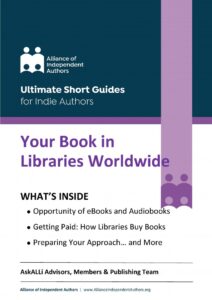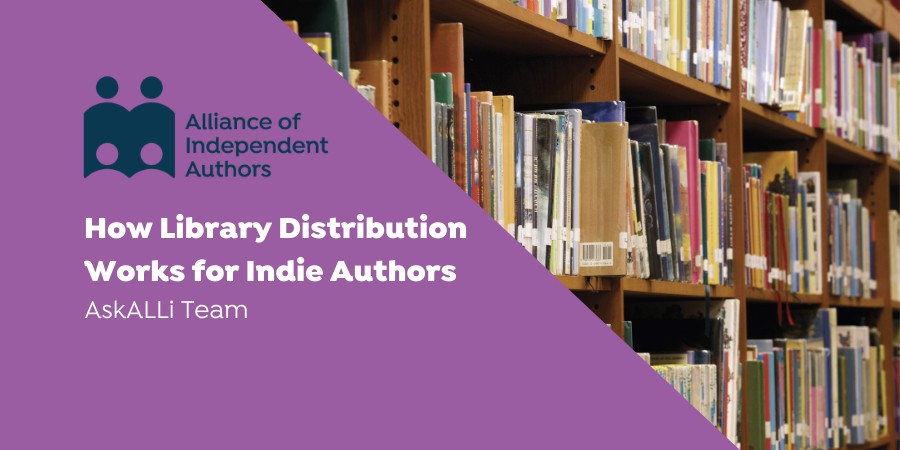 ALLi members can download a complimentary ebook copy of Your Book in Libraries Worldwide in the Member Zone. Navigate to allianceindependentauthors.org and log in. Then navigate to the following menu: BOOKS > SHORTGUIDES. Other formats are available to members and non-members in ALLi’s Bookshop
ALLi members can download a complimentary ebook copy of Your Book in Libraries Worldwide in the Member Zone. Navigate to allianceindependentauthors.org and log in. Then navigate to the following menu: BOOKS > SHORTGUIDES. Other formats are available to members and non-members in ALLi’s Bookshop
Do you think libraries don’t buy books from self-published authors? Think again. In a 2016 survey conducted by US-based publishing service New Shelves Books, 92 percent of librarians reported that they regularly purchase from self-published authors and small presses.
Clearly, librarians are buying self-published books that fit their acquisition guidelines. And libraries are full of avid readers.
- Public: Government-funded local and national libraries serve the general public.
- Academic: The college and university library market, although smaller, usually has more money than the public sector to spend on books.
- School: With smaller budgets than public or academic libraries, school libraries are important for children’s or YA (young adult) writers. In the US, there are only two wholesalers selling into the school market. They sell library binding (heavy bound) books that hold up to the often rough treatment from school kids. If you’re serious about selling to the school library market, you’ll need to partner with and pay one of these two wholesalers for the coding and library binding system.
- Special: Corporate libraries, usually privately run, are devoted to specific purposes, such as medical or law, with budgets from tiny to huge—significant for niche writers.
It’s easy to obtain a list of libraries through your local, regional, or national library association. The next task is to understand which distributor supplies their books. Here is a list of the most important distributors of books to libraries, globally.
- Overdrive for ebooks, audiobooks, and videos is the world’s largest library eBook platform, offering a procurement and checkout system for over 40,000 public libraries and schools around the world. Baker & Taylor, now owned by Follett, one of the largest distributors of both digital and print books worldwide to thousands of libraries, publishers and retailers.
- Bibliotheca Bibliotheca’s digital lending platform, used by more than 30,000 libraries around the world, is called cloudLibrary. Ebooks are supplied through distributors and publishing platforms. There is minimal curation, mostly for technical aspects.
- James Bennett, library vendor in the Australasian marketplace
- Gardners in the UK, a wholesaler of books, ebooks, music, and film to retailers around the world.
- Draft2Digital, distributing ebooks via partnerships with Overdrive and Hoopla
- Findaway Voices’ distributing audiobooks to retail and library distribution partners globally.
- IngramSpark, distributes to more than 39,000 retailers and libraries for print and ebooks.
- Kobo Writing Life is a sister company to OverDrive, the largest distributor of ebooks to libraries
- Self-e Library Journal offering access mainly to US libraries, via its PatronsFirst delivery platform. Until recently Self-e was a free platform but is now exploring a paid model.
“It’s important for authors to recognize that these services are not like for like. They offer different options depending on territory, career priorities, and marketing strategy. Authors must have a clear sense of what they hope to achieve from their book’s availability in a library system and choose accordingly.” John Doppler, Choosing the Best Self-Publishing Services and Companies
Amazon and Walmart
How You’ll Get Paid
- OC/OU is “one copy, one user” and is the standard library model, mimicking that of physical books. Libraries purchase a single copy and can loan it to one library patron at a time. When one person has your book checked out, no one else can “borrow” the book until the first person has “returned” the digital book. If a library wants to be able to loan the book to more than one person at a time, they’ll have to “purchase” another “copy.” Payment to authors under the OC/OU model is usually three times the list (retail) price, however it will be a single payment at the time the library purchases your title.
- CPC stands for “cost per checkout.” This is sometimes referred to as “simultaneous use” and it means libraries can loan the digital book product (eBook or audio) to many readers at the same time. Payment to authors under this model is 1/10th the list price per loan. So, your payments will be smaller per reader, but there is the potential for payment with each reader. This model also promises greater exposure for your book, simply because more readers at a time means more people talking and recommending your book to others.
Public Lending Rights (PLR)
The PLR is the legal right that allows authors and other right holders to receive payment from government to compensate for the free loan of their books by public and other libraries.
Jim Parker, Coordinator of the PLR International Network says:
As of 2018, there were thirty-three countries with PLR systems.1 It’s been recognized in the EU since 1992. In 1946, Denmark was the first country to implement a PLR, quickly followed in 1947 and 1954 by Norway and Sweden. I 1973, New Zealand was the first non-European country to set up a PLR system. Australia and Canada followed in 1974 and Israel in 1986. Poland’s PLR system is the most recent to begin operating, with the first payments to authors made in 2016.In most cases, PLR payments do not come out of library budgets, but are funded by regional or national governments. There are a few cases where libraries pay for PLR, for example in the Netherlands, where public libraries are independent entities. PLR is managed in one of three ways.
- By a collective management organization, as it in in Spain, Germany, the Netherlands, Lithuania, and Slovakia.
- Legislated and administered by a government body. This is the case in the UK, where PLR is administered by the British Library.
- Funded directly by government without underlying legislation. Canada, Israel, and Malta all operate this way.
Different Approaches to PLR Payments
Maggie Lynch: Working with Libraries

Maggie Lynch
Maggie Lynch, longtime ALLi author member, is the author of 20+ published books. Her fiction tells stories of men and women making heroic choices one messy moment at a time. Find out more about Maggie on her website maggielynch.com
So far, I’ve found that the best approach to libraries is twofold:
- Offer to do something for them so they get to know you and your reliability and skills. e.g., a virtual author meeting (or in person when COVID is over); host a panel; have a variety of things you can speak on that a library appreciates).
- Send an email with a one-sheet about your book to the librarian on record for acquisitions in your genre, or the head librarian. Not everyone appreciates getting the one sheets, but my experience has been that only 10% completely ignore them. It helps to include information about which libraries already catalog your books (ebooks or print). It is easier for them to say yes when they know others have already purchased.
Libraries are a hard nut to crack, but they are slowly becoming more open to indies with a track record. What most of them will NOT do is accept a free book to be cataloged, or an obvious email with multiple libraries listed and a direct request for them to purchase. Like everything in life, it takes time and effort to build a list of current librarians and then approach them one by one with information that is interesting to them.
Finally, by participating in the cost-per-circulation (CPC) option in ebook library distribution (offered by Overdrive, Bibliotecha, and Hoopla) it is easier for librarians to take a chance on new authors because they don’t have to purchase the book at full price without knowing whether it fits what their patrons want to check out. CPC allows them to pay a portion of the price with every checkout (usually about 10% depending on the vendor and licensing). In that way, they can show a larger catalog of potential ebooks for library download without committing to paying full price for any of those books. For those authors who think: “I’m not going to allow them to only pay me 10% or less of full price.” I implore you to think again. Once that book is checked out 10 times it will have paid for the full price AND any subsequent checkouts is above the full price they would have paid for a one time forever license for one book (which used to be the old way of doing ebooks just two to three years ago). It is the old way that kept most libraries only ordering bestsellers because they knew they would circulate.





Is the library supposed to get back with a local author after receiving their books to tell them whether or not their books been accepted in that library?
Hello!
My name is Dani, and I am a children’s illustrator and am in the process of self publishing my first illustrated collection of poems. I am researching further on topics of marketing and strategies in pricing my book to libraries, and also setting global pricing for distributions. I discovered this website and am so grateful for this platform of articles! Might you be able to lead me to any articles or resources pertaining to pricing for libraries ? Thank you so much 🙂
I send a couple of copies of my books to each of the public libraries I’ve worked at and also to my current local library authority. (It’s cheaper than advertising.)
My novel, “Einstein’s Compass a YA Time Traveler Adventure” is on all the platforms you have listed. Einstein’s Compass has won ten books awards, including an audiobook award and cover award. Story Monster approved too. I have won the Indie Author project for Texas, which is supported by the library system in the USA. I have contacted my local library to share my book and offered to do library activities. I have advertised in IBPA library publications and Story Monster ads. My book is Lexile rated at 860.
I spoke to my local librarian, who said they are not carrying my book. Sorry, but to say but I think Indie authors are quietly being shunned.
I have heard they do not have the budget to buy Indie books. The latest is the librarians do not have the time to vet the books to make sure they meet their standards. I have spent thousands of dollars to have an editor, professional cover, websites, social media and do all the steps to make my books as good as any from a traditional publisher. So I would like to know what I need to do next please tell me because I think the door to libraries for Indie authors is still not open.
Sorry to hear that Grace. It’s not an automatic thing, for trade-published or self-published books. Have said that, we do hear of instances like yours still, but we also know that self-published books *are* being carried by libraries worldwide. Yes, there are still obstacles to surmount and still certain librarians, or staff in library buying centers, who are not open, and say things like you quote here. Have you tried speaking to your local librarian and asking that question: “what do I need to do next please so you will stock it?” Then find out where they get their books and speak to the next person up, in the buying chain. There are tips in our book which help a publisher approach the task of getting their books stocked.
Grace,
I totally agree with you, and am pleased that I am not alone in this! Congrats on all your awards.
The libraries are still hard (if not impossible) for self-published authors to access in Toronto, Canada.
Pre-Covid, I was able to approach library Heads, who ordered my paperback, and created events at individual branches, yet Overdrive did not accept self-published ebooks. Now, even though my distributor supposedly reaches Overdrive, my only access to the library at all is through their central online vetting system, which did accept the paperback, but referred me to the Indie Author Project which vets ebooks for “Biblioboard”. No mention of Overdrive, even though the ebook is supposedly listed in a “special” catalogue of self-published authors, but it seems no one can access that catalogue, because it takes a real person talking to another real person to open it. I have contacted all the wonderfully helpful Branch Heads that I worked with pre-Covid and they can’t do anything to help. It’s very frustrating…
Sharon
Hi, I was trying one of the links in your wonderful article, and it doesn’t work.
“ALLi Watchdog John Doppler considers each of these library access services in more detail in Choosing the Best Self-Publishing Services and Companies”
Thanks for the great info!
Cheryl